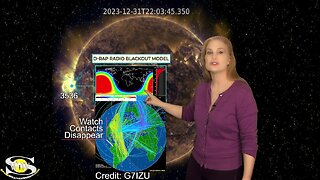Premium Only Content

The Eclipse Brings Space Weather: Solar Storm Forecast 08-17-2017
Are you ready for the Eclipse August 21st? Did you know it brings its own unique kind of Space Weather? Learn more about how the eclipse will affect you, see when the next solar storm will hit and where aurora might be visible, and catch the recent flare activity from the new sunspot that has rotated into Earth view this week.
General Eclipse Info: https://eclipse2017.nasa.gov/
NASA TV Live Eclipse Broadcast:
https://eclipse2017.nasa.gov/eclipse-live-stream
For daily and often hourly updates (during active times) visit me on Twitter:
https://twitter.com/TamithaSkov
For a more in-depth look at the data and images highlighted in this video see these links below.
Solar Imaging and Analysis:
SDO: http://sdo.gsfc.nasa.gov/data/
Helioviewer: http://www.helioviewer.org/
STEREO-EUVI + SDO-AIA 360° Heliographic Maps: http://tcrb.nrl.navy.mil/~iuu/maps360/284/movietool.html
Flare Analysis: http://www.lmsal.com/solarsoft/latest_events/
Computer Aided CME Tracking CACTUS: http://www.sidc.oma.be/cactus/out/latestCMEs.html
GOES Xray: http://www.swpc.noaa.gov/rt_plots/xray_1m.html
SOHO: http://sohodata.nascom.nasa.gov/
Stereo: http://stereo.gsfc.nasa.gov/
NOAA Sunspot Classifications: http://www.swpc.noaa.gov/ftpdir/latest/
GONG: http://gong2.nso.edu/dailyimages/
GONG Magnetic Maps: http://gong.nso.edu/data/magmap/
LMSAL Heliophysics Events HEK http://www.lmsal.com/isolsearch
Solar Wind:
NOAA/SWPC: http://www.swpc.noaa.gov
ACE Solar Wind: http://www.swpc.noaa.gov/ace/ace_rtsw_data.html
Wang-Sheeley-Arge Solar Wind Prediction Model: http://www.swpc.noaa.gov/ws/
NASA ENLIL SPIRAL: http://iswa.gsfc.nasa.gov:8080/IswaSy...
NOAA ENLIL SPIRAL: http://www.swpc.noaa.gov/wsa-enlil/
Magnetosphere, Ionosphere, Atmosphere:
GOES Magnetometer: http://www.swpc.noaa.gov/rt_plots/mag_3d.html
Ionosphere D-Region Absorption (DRAP) model: http://www.swpc.noaa.gov/drap/
Auroral Oval Ovation Products: http://helios.swpc.noaa.gov/ovation/
POES Auroral Global Maps: http://www.swpc.noaa.gov/pmap/
Global 3-hr Kp index: http://www.swpc.noaa.gov/rt_plots/kp_3d.html
Wing Kp index prediction: http://www.swpc.noaa.gov/wingkp/index.html
USGS Ground Magnetometers: http://geomag.usgs.gov/realtime/
USGS Disturbance Storm-Time (Dst): http://geomag.usgs.gov/realtime/dst/
NAIRAS Radiation Storm Model: http://terra2.spacenvironment.net/~raps_ops/current_files/globeView.html
HAARP Data Meters: http://www.haarp.alaska.edu/haarp/
Multi-Purpose Space Environment Sites:
SOLARHAM: http://www.solarham.net/index.htm
Spaceweather: http://spaceweather.com
SOLARIMG: http://solarimg.org/artis/
iSWA: http://iswa.gsfc.nasa.gov/iswa/iSWA.html
Definition of Geomagnetic Storm, Radiation Storm, and Radio Blackout Levels:
http://www.swpc.noaa.gov/NOAAscales/
None of this would be possible without the hard work and dedication of those who have provided all of this data for public use.
Images c/o NASA/ESA/CSA (most notably the superb SDO, SOHO, ACE, STEREO, CCMC, JPL & DSN teams, amazing professionals, hobbyists, institutions, organizations, agencies and amateurs such as those at the USAF/HAARP, NICT, NOAA, USGS, Environment Canada, Natural Resources Canada, Intellicast, Catatania, rice.edu, wisc.edu, sonoma.edu ucalgary.ca, rssi.ru, ohio-state.edu, solen.info, and more. Thanks for making Space Weather part of our every day dialogue.
-
 12:43
12:43
Dr. Tamitha Skov
1 year ago $0.22 earnedBiggest X-Flare of Cycle 25 & Super Storm Launch | Space Weather Spotlight 02 January 2024
607 -
 LIVE
LIVE
MYLUNCHBREAK CHANNEL PAGE
1 hour agoThe Population Was ZERO
452 watching -
 LIVE
LIVE
Wendy Bell Radio
6 hours agoTrump Cracks The Barrel
7,299 watching -
 LIVE
LIVE
The Big Mig™
3 hours ago2020 Election Fraud Burn Bags Discovered
5,152 watching -
 LIVE
LIVE
Law&Crime
2 hours agoLIVE: Adelson Matriarch Murder Trial — FL v. Donna Adelson — Day 4
119 watching -
 LIVE
LIVE
Badlands Media
10 hours agoBadlands Daily: August 27, 2025
3,775 watching -
 LIVE
LIVE
The State of Freedom
5 hours agoFLF: #15 Obedience to God Unlocks Mysteries & Brings Adventure w/ Dave Hayes
87 watching -
 1:03:42
1:03:42
Crypto Power Hour
3 hours agoWhat Coins Are The Backbone of The New Digital Revolution?
6.36K6 -
 1:22:55
1:22:55
Game On!
20 hours ago $2.62 earnedBREAKING NFL NEWS: Taylor Swift and Travis Kelce Are Engaged!
39.3K13 -
 41:04
41:04
Coin Stories with Natalie Brunell
1 day agoCooking, Culture & Crypto: Norma Chu’s Food Empire Turns Bitcoin Treasury
35.4K